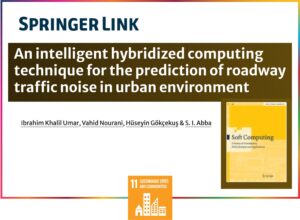
Researchers Nourani and Gökçekuş from Faculty of Civil and Environmental Engineering, Near East University contributed as co-authors to a study focusing on predicting roadway traffic noise in Nicosia, North Cyprus, aiming to provide insights for creating a noise-friendly environment. The study proposed four linear-nonlinear hybrid models to capture both linear and nonlinear patterns of traffic noise data. Initially, the potential of various artificial intelligence-based models and linear regression was assessed. Among these, MLR-GPR hybrid model demonstrated superior prediction capability, outperforming other models significantly.
The study collected data from 12 sites on four road classes, revealing that average traffic noise levels exceeded the recommended safe threshold of 55 dBA for European countries. The highest noise levels were observed along expressways, contrasting with lower levels on local roads. Input variable selection, crucial for machine learning performance, identified the most relevant parameters for traffic noise prediction in Nicosia.
Results indicated that nonlinear models outperformed linear models, showcasing improved performance ranging from 10.33% to 20.9% compared to MLR. Subsequently, the study explored hybrid models by combining linear and nonlinear approaches, with MLR-GPR emerging as the most efficient hybrid model, enhancing the efficiency of MLR and GPR by up to 27.26% and 10.30%, respectively.
The findings underscored the significance of incorporating stronger nonlinear models alongside linear ones for accurate traffic noise prediction. This research holds implications for stakeholders in developing noise maps with higher accuracy, facilitating informed decision-making for noise mitigation measures. Notably, the study revealed that inhabitants of Nicosia are exposed to noise levels significantly above the recommended threshold, underscoring the urgent need for noise reduction initiatives along roadways.
In conclusion, the study highlights the importance of integrating advanced modeling techniques to predict and address roadway traffic noise effectively. Future research may explore additional linear models for developing hybrid models to further enhance noise prediction accuracy. Overall, this research contributes valuable insights for creating a noise-friendly environment in Nicosia and potentially other urban areas facing similar challenges.
More Information:
https://link.springer.com/article/10.1007/s00500-023-07826-5